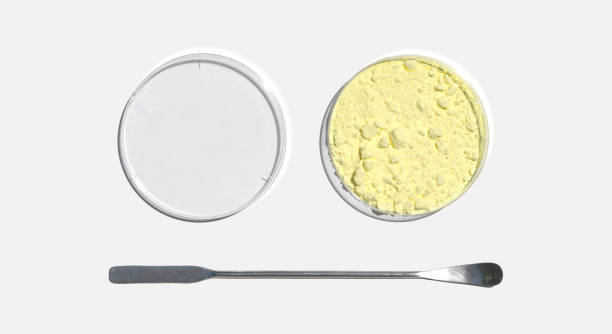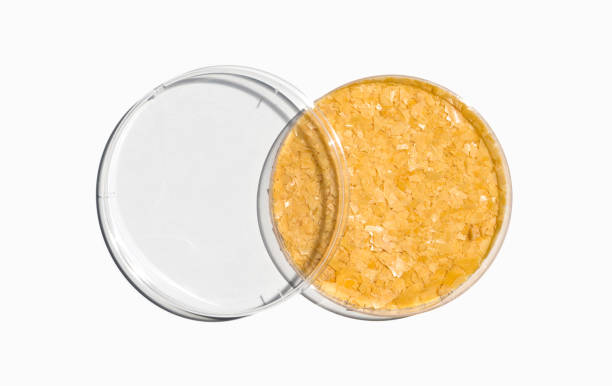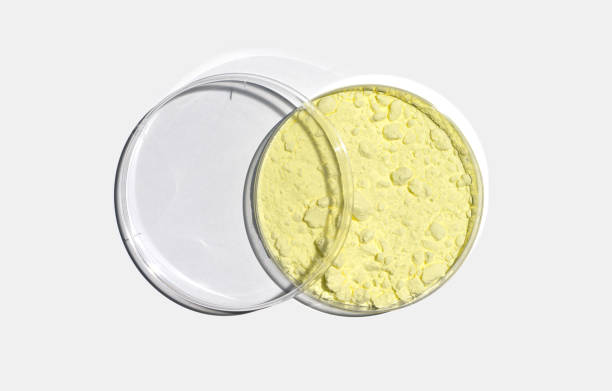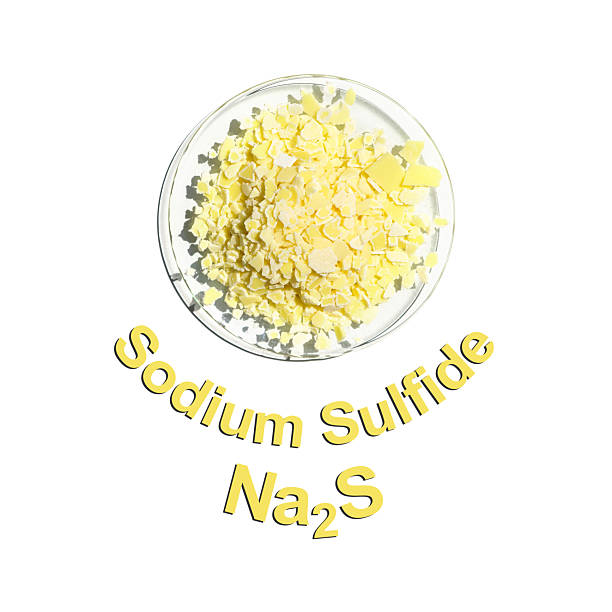Sodium sulfide (Na₂S) is an important inorganic compound with significant industrial and laboratory uses. Known for its strong reducing ability and high reactivity, it serves as a key chemical in the leather, textile, paper, and chemical manufacturing industries. This detailed guide covers all essential aspects of sodium sulfide, including its properties, structure, methods of preparation, major applications, and important safety precautions.
Introduction to Sodium Sulfide
Sodium sulfide is an ionic compound made up of sodium (Na⁺) and sulfide (S²⁻) ions. It typically appears as yellowish to brick-red solid flakes or crystals and is highly soluble in water, resulting in a strongly alkaline solution. Its chemical formula is Na₂S, and its molar mass is 78.04 g/mol.
When exposed to moist air, sodium sulfide gradually undergoes oxidation, releasing hydrogen sulfide (H₂S) gas, which has a characteristic foul odor of rotten eggs.
Chemical Formula and Structure
- Chemical formula: Na₂S
- Molecular weight: 78.04 g/mol
- Composition: Two sodium cations (Na⁺) and one sulfide anion (S²⁻)
- Crystal structure: Antifluorite type
In this structure, each sulfide ion is surrounded by eight sodium ions, and each sodium ion is coordinated to four sulfide ions, giving the compound its high ionic strength and stability.
Physical Properties of Sodium Sulfide
| Property | Description |
|---|---|
| Appearance | Yellow to brick-red solid |
| Odor | Pungent, similar to rotten eggs |
| Molar Mass | 78.04 g/mol |
| Melting Point | 1,176 °C (2,149 °F) |
| Boiling Point | Decomposes before boiling |
| Solubility | Highly soluble in water, forming alkaline solutions |
| Density | 1.86 g/cm³ |
| pH (1% solution) | Approximately 13 (strongly basic) |
The color variation is mainly due to the presence of polysulfide impurities that give sodium sulfide a yellowish or reddish appearance.
Chemical Properties of Sodium Sulfide

Sodium sulfide is a strong reducing agent and readily participates in redox reactions. Some of its notable chemical behaviors include:
- Reaction with Acids:
When sodium sulfide reacts with acids such as hydrochloric acid, it releases hydrogen sulfide gas (H₂S).
[Na₂S + 2HCl → 2NaCl + H₂S↑] - Reaction with Oxygen:
On exposure to air, it slowly oxidizes to form sodium thiosulfate (Na₂S₂O₃) and sodium sulfate (Na₂SO₄).
[2Na₂S + 2O₂ → 2Na₂SO₃] - Reaction with Metal Ions:
Sodium sulfide reacts with metal salts such as copper(II) sulfate to form metal sulfides, which are often insoluble.
[Na₂S + CuSO₄ → CuS↓ + Na₂SO₄]
These properties make sodium sulfide an essential reagent in analytical and industrial chemistry.
Preparation of Sodium Sulfide
Sodium sulfide can be prepared by several methods, both industrially and in laboratories. The common preparation techniques include:
1. Reduction of Sodium Sulfate with Carbon
This is the primary industrial method used to produce sodium sulfide:
[Na₂SO₄ + 2C → Na₂S + 2CO₂]
This reaction takes place at high temperatures in a reducing environment, typically within a rotary furnace.
2. Direct Combination of Sodium and Sulfur
Pure sodium sulfide can also be prepared by directly combining elemental sodium and sulfur:
[2Na + S → Na₂S]
However, this method is highly exothermic and requires strict control to prevent explosions.
3. From Sodium Hydroxide and Hydrogen Sulfide
Another laboratory-scale preparation involves bubbling hydrogen sulfide gas through a sodium hydroxide solution:
[2NaOH + H₂S → Na₂S + 2H₂O]
This method is often used to produce aqueous sodium sulfide solutions for chemical applications.
Applications of Sodium Sulfide

Sodium sulfide is a versatile compound with wide-ranging industrial applications. Some of its major uses include:
1. Leather Industry
Sodium sulfide is extensively used in the leather tanning process, where it helps remove hair, wool, and other impurities from animal hides. It acts as a dehairing agent and also helps in liming to prepare the hides for further treatment.
2. Textile Industry
In textile manufacturing, sodium sulfide is employed in the dyeing of synthetic fibers like polyester and nylon. It also functions as a reducing agent in vat dyeing processes and aids in dissolving sulfur dyes.
3. Pulp and Paper Industry
The compound is essential in the Kraft process of paper production. Sodium sulfide, combined with sodium hydroxide, assists in breaking down lignin, enabling the separation of cellulose fibers from wood.
4. Chemical Manufacturing
Sodium sulfide acts as a precursor in the synthesis of several inorganic sulfides, such as zinc sulfide, copper sulfide, and antimony sulfide. It is also used in producing sodium hydrosulfide (NaHS) and various organic sulfur compounds.
5. Water Treatment
Sodium sulfide is employed to remove heavy metals from wastewater by precipitating them as insoluble metal sulfides, thereby aiding in environmental cleanup.
6. Mining Industry
In the flotation process of ores, sodium sulfide acts as a sulfurizing agent and helps separate oxide ores from other materials.
Safety and Handling Precautions
Sodium sulfide is a highly reactive and toxic substance, and strict precautions must be taken during its use.
- Avoid inhalation of vapors or dust; hydrogen sulfide gas is toxic and flammable.
- When handling the substance, it’s important to wear protective gear like gloves, goggles, and face masks.
- Store in airtight containers to prevent contact with moisture and air.
- If sodium sulfide comes into contact with acids, move to a well-ventilated area immediately, as hydrogen sulfide gas may be released.
- Dispose of sodium sulfide waste according to local environmental regulations.
Environmental Impact

If not handled properly, sodium sulfide can cause serious environmental harm, particularly through the release of hydrogen sulfide gas. It may pollute water sources and pose a threat to aquatic life. Therefore, industrial waste containing sodium sulfide should be carefully treated before being discharged.
Storage and Stability
Sodium sulfide must be kept in a cool, dry, and well-ventilated location, away from acids and oxidizing substances. Containers should be tightly closed to avoid moisture absorption and oxidation. Although it remains stable under normal storage conditions, it gradually decomposes when exposed to humid air.
Conclusion
Sodium sulfide (Na₂S) is an indispensable chemical in various industries due to its strong reducing nature, reactivity, and versatility. From leather processing and textile dyeing to pulp production and wastewater treatment, it serves multiple purposes. However, its handling requires caution due to its toxicity and corrosive nature. Understanding its properties, reactions, and safety guidelines ensures that it can be used efficiently and responsibly in both industrial and laboratory environments.
How is sodium sulfide prepared?
What is sodium sulfide?
Sodium sulfide (Na₂S) is an important inorganic compound with significant industrial and laboratory uses. Known for its strong reducing ability and high reactivity, it serves as a key chemical in the leather, textile, paper, and chemical manufacturing industries. This detailed guide covers all essential aspects of sodium sulfide, including its properties, structure, methods of preparation, major applications, and important safety precautions.
Introduction
It is an ionic compound made up of sodium (Na⁺) and sulfide (S²⁻) ions. It typically appears as yellowish to brick-red solid flakes or crystals and is highly soluble in water, resulting in a strongly alkaline solution. Its chemical formula is Na₂S, and its molar mass is 78.04 g/mol.
When exposed to moist air, sodium sulfide gradually undergoes oxidation, releasing hydrogen sulfide (H₂S) gas, which has a characteristic foul odor of rotten eggs.
Chemical Formula and Structure
Chemical formula: Na₂S
Molecular weight: 78.04 g/mol
Composition: Two sodium cations (Na⁺) and one sulfide anion (S²⁻)
Crystal structure: Antifluorite type
In this structure, each sulfide ion is surrounded by eight sodium ions, and each sodium ion is coordinated to four sulfide ions, giving the compound its high ionic strength and stability.
Physical Properties
| Property | Description |
|---|---|
| Appearance | Yellow to brick-red solid |
| Odor | Pungent, similar to rotten eggs |
| Molar Mass | 78.04 g/mol |
| Melting Point | 1,176 °C (2,149 °F) |
| Boiling Point | Decomposes before boiling |
| Solubility | Highly soluble in water, forming alkaline solutions |
| Density | 1.86 g/cm³ |
| pH (1% solution) | Approximately 13 (strongly basic) |
The color variation is mainly due to the presence of polysulfide impurities that give sodium sulfide a yellowish or reddish appearance.
Chemical Properties
It is a strong reducing agent and readily participates in redox reactions. Some of its notable chemical behaviors include:
Reaction with Acids:
When It reacts with acids such as hydrochloric acid, it releases hydrogen sulfide gas (H₂S).
[Na₂S + 2HCl → 2NaCl + H₂S↑]
Reaction with Oxygen:
On exposure to air, it slowly oxidizes to form sodium thiosulfate (Na₂S₂O₃) and sodium sulfate (Na₂SO₄).
[2Na₂S + 2O₂ → 2Na₂SO₃]
Reaction with Metal Ions:
It reacts with metal salts such as copper(II) sulfate to form metal sulfides, which are often insoluble.
[Na₂S + CuSO₄ → CuS↓ + Na₂SO₄]
These properties make It an essential reagent in analytical and industrial chemistry.
Preparation
Sodium sulfide can be prepared by several methods, both industrially and in laboratories. The common preparation techniques include:
1. Reduction with Carbon
This is the primary industrial method used to produce sodium sulfide:
[Na₂SO₄ + 2C → Na₂S + 2CO₂]
This reaction takes place at high temperatures in a reducing environment, typically within a rotary furnace.
2. Direct Combination of Sodium and Sulfur
Pure. It can also be prepared by directly combining elemental sodium and sulfur:
[2Na + S → Na₂S]
However, this method is highly exothermic and requires strict control to prevent explosions.
3. From Sodium Hydroxide and Hydrogen Sulfide
Another laboratory-scale preparation involves bubbling hydrogen sulfide gas through a sodium hydroxide solution:
[2NaOH + H₂S → Na₂S + 2H₂O]
This method is often used to produce aqueous sodium sulfide solutions for chemical applications.
Applications
It is a versatile compound with wide-ranging industrial applications. Some of its major uses include:
1. Leather Industry
It is extensively used in the leather tanning process, where it helps remove hair, wool, and other impurities from animal hides. It acts as a dehairing agent and also helps in liming to prepare the hides for further treatment.
2. Textile Industry
In textile manufacturing, It is employed in the dyeing of synthetic fibers like polyester and nylon. It also functions as a reducing agent in vat dyeing processes and aids in dissolving sulfur dyes.
3. Pulp and Paper Industry
The compound is essential in the Kraft process of paper production. It, combined with sodium hydroxide, assists in breaking down lignin, enabling the separation of cellulose fibers from wood.
4. Chemical Manufacturing
It acts as a precursor in the synthesis of several inorganic sulfides, such as zinc sulfide, copper sulfide, and antimony sulfide. It is also used in producing sodium hydrosulfide (NaHS) and various organic sulfur compounds.
5. Water Treatment
It is employed to remove heavy metals from wastewater by precipitating them as insoluble metal sulfides, thereby aiding in environmental cleanup.
6. Mining Industry
In the flotation process of ores, It acts as a sulfurizing agent and helps separate oxide ores from other materials.
Safety and Handling Precautions
It is a highly reactive and toxic substance, and strict precautions must be taken during its use.
Avoid inhalation of vapors or dust; hydrogen sulfide gas is toxic and flammable.
When handling the substance, it’s important to wear protective gear like gloves, goggles, and face masks.
Store in airtight containers to prevent contact with moisture and air.
If it comes into contact with acids, move to a well-ventilated area immediately, as hydrogen sulfide gas may be released.
Dispose of sodium sulfide waste according to local environmental regulations.
Environmental Impact
If not handled properly, sodium sulfide can cause serious environmental harm, particularly through the release of hydrogen sulfide gas. It may pollute water sources and pose a threat to aquatic life. Therefore, industrial waste containing sodium sulfide should be carefully treated before being discharged.
Storage and Stability
It must be kept in a cool, dry, and well-ventilated location, away from acids and oxidizing substances. Containers should be tightly closed to avoid moisture absorption and oxidation. Although it remains stable under normal storage conditions, it gradually decomposes when exposed to humid air.
Conclusion
It is an indispensable chemical in various industries due to its strong reducing nature, reactivity, and versatility. From leather processing and textile dyeing to pulp production and wastewater treatment, it serves multiple purposes. However, its handling requires caution due to its toxicity and corrosive nature. Understanding its properties, reactions, and safety guidelines ensures that it can be used efficiently and responsibly in both industrial and laboratory environments.
What are the main uses of sodium sulfide?
What is the chemical formula and molar mass of sodium sulfide?
Is sodium sulfide soluble in water?
What is the environmental impact of sodium sulfide?
Is sodium sulfide the same as sodium hydrosulfide?
What is the use of sodium sulfide?
Sodium sulfide (Na₂S) is an important inorganic compound with significant industrial and laboratory uses. Known for its strong reducing ability and high reactivity, it serves as a key chemical in the leather, textile, paper, and chemical manufacturing industries. This detailed guide covers all essential aspects of It, including its properties, structure, methods of preparation, major applications, and important safety precautions.
Introduction
It is an ionic compound made up of sodium (Na⁺) and sulfide (S²⁻) ions. It typically appears as yellowish to brick-red solid flakes or crystals and is highly soluble in water, resulting in a strongly alkaline solution. Its chemical formula is Na₂S, and its molar mass is 78.04 g/mol.
When exposed to moist air, sodium sulfide gradually undergoes oxidation, releasing hydrogen sulfide (H₂S) gas, which has a characteristic foul odor of rotten eggs.
Chemical Formula and Structure
Chemical formula: Na₂S
Molecular weight: 78.04 g/mol
Composition: Two sodium cations (Na⁺) and one sulfide anion (S²⁻)
Crystal structure: Antifluorite type
In this structure, each sulfide ion is surrounded by eight sodium ions, and each sodium ion is coordinated to four sulfide ions, giving the compound its high ionic strength and stability.
Physical Properties
| Property | Description |
|---|---|
| Appearance | Yellow to brick-red solid |
| Odor | Pungent, similar to rotten eggs |
| Molar Mass | 78.04 g/mol |
| Melting Point | 1,176 °C (2,149 °F) |
| Boiling Point | Decomposes before boiling |
| Solubility | Highly soluble in water, forming alkaline solutions |
| Density | 1.86 g/cm³ |
| pH (1% solution) | Approximately 13 (strongly basic) |
Chemical Properties
Sodium sulfide is a strong reducing agent and readily participates in redox reactions. Some of its notable chemical behaviors include:
Reaction with Acids:
When it reacts with acids such as hydrochloric acid, it releases hydrogen sulfide gas (H₂S).
[Na₂S + 2HCl → 2NaCl + H₂S↑]
Reaction with Oxygen:
On exposure to air, it slowly oxidizes to form sodium thiosulfate (Na₂S₂O₃) and sodium sulfate (Na₂SO₄).
[2Na₂S + 2O₂ → 2Na₂SO₃]
Reaction with Metal Ions:
It reacts with metal salts such as copper(II) sulfate to form metal sulfides, which are often insoluble.
[Na₂S + CuSO₄ → CuS↓ + Na₂SO₄]
These properties make it an essential reagent in analytical and industrial chemistry.
Preparation of Sodium Sulfide
Sodium sulfide can be prepared by several methods, both industrially and in laboratories. The common preparation techniques include:
1. Reduction of Sodium Sulfate with Carbon
This is the primary industrial method used to produce it:
[Na₂SO₄ + 2C → Na₂S + 2CO₂]
This reaction takes place at high temperatures in a reducing environment, typically within a rotary furnace.
2. Direct Combination of Sodium and Sulfur
Pure sodium sulfide can also be prepared by directly combining elemental sodium and sulfur:
[2Na + S → Na₂S]
However, this method is highly exothermic and requires strict control to prevent explosions.
3. From Sodium Hydroxide and Hydrogen Sulfide
Another laboratory-scale preparation involves bubbling hydrogen sulfide gas through a sodium hydroxide solution:
[2NaOH + H₂S → Na₂S + 2H₂O]
This method is often used to produce aqueous sodium sulfide solutions for chemical applications.
Applications of Sodium Sulfide
Sodium sulfide is a versatile compound with wide-ranging industrial applications. Some of its major uses include:
1. Leather Industry
It is extensively used in the leather tanning process, where it helps remove hair, wool, and other impurities from animal hides. It acts as a dehairing agent and also helps in liming to prepare the hides for further treatment.
2. Textile Industry
In textile manufacturing, it is employed in the dyeing of synthetic fibers like polyester and nylon. It also functions as a reducing agent in vat dyeing processes and aids in dissolving sulfur dyes.
3. Pulp and Paper Industry
The compound is essential in the Kraft process of paper production. Sodium sulfide, combined with sodium hydroxide, assists in breaking down lignin, enabling the separation of cellulose fibers from wood.
4. Chemical Manufacturing
It acts as a precursor in the synthesis of several inorganic sulfides, such as zinc sulfide, copper sulfide, and antimony sulfide. It is also used in producing sodium hydrosulfide (NaHS) and various organic sulfur compounds.
5. Water Treatment
Sodium sulfide is employed to remove heavy metals from wastewater by precipitating them as insoluble metal sulfides, thereby aiding in environmental cleanup.
6. Mining Industry
In the flotation process of ores, it acts as a sulfurizing agent and helps separate oxide ores from other materials.
Safety and Handling Precautions
Sodium sulfide is a highly reactive and toxic substance, and strict precautions must be taken during its use.
Avoid inhalation of vapors or dust; hydrogen sulfide gas is toxic and flammable.
When handling the substance, it’s important to wear protective gear like gloves, goggles, and face masks.
Store in airtight containers to prevent contact with moisture and air.
If sodium sulfide comes into contact with acids, move to a well-ventilated area immediately, as hydrogen sulfide gas may be released.
Dispose of sodium sulfide waste according to local environmental regulations.
Environmental Impact
If not handled properly, it can cause serious environmental harm, particularly through the release of hydrogen sulfide gas. It may pollute water sources and pose a threat to aquatic life. Therefore, industrial waste containing sodium sulfide should be carefully treated before being discharged.
Storage and Stability
Sodium sulfide must be kept in a cool, dry, and well-ventilated location, away from acids and oxidizing substances. Containers should be tightly closed to avoid moisture absorption and oxidation. Although it remains stable under normal storage conditions, it gradually decomposes when exposed to humid air.
Conclusion
Sodium sulfide (Na₂S) is an indispensable chemical in various industries due to its strong reducing nature, reactivity, and versatility. From leather processing and textile dyeing to pulp production and wastewater treatment, it serves multiple purposes. However, its handling requires caution due to its toxicity and corrosive nature. Understanding its properties, reactions, and safety guidelines ensures that it can be used efficiently and responsibly in both industrial and laboratory environments.
